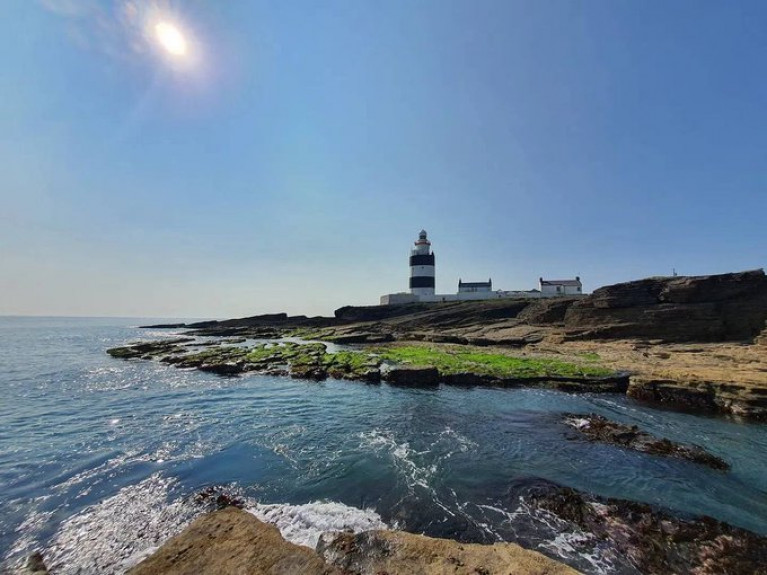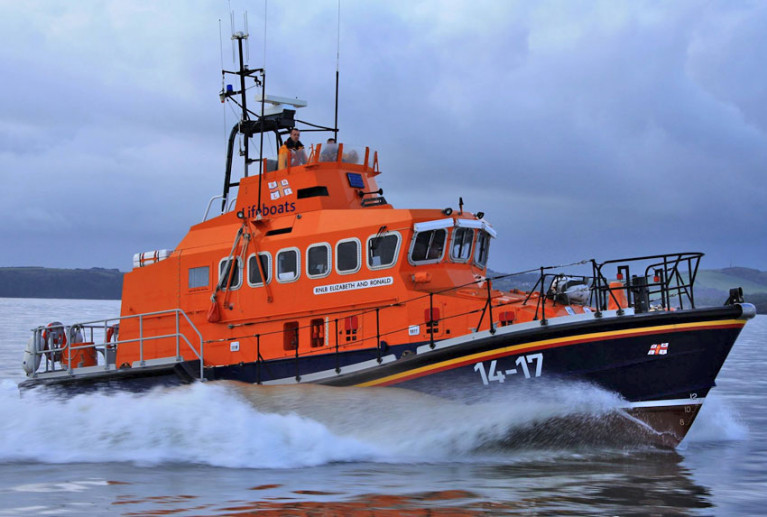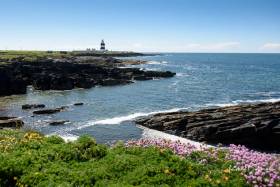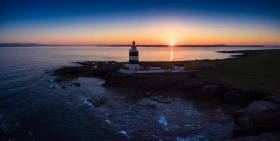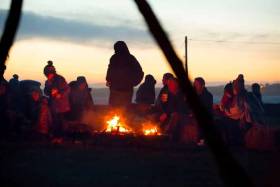Displaying items by tag: Hook Head
Fossil Sea Urchins Dating Back 350 Million Years Found Near Hook Head, Co Wexford
A group of sea urchins which died together on the seafloor almost 350 million years ago have been found in fossilised form at Hook Head, Co Wexford, by a team of scientists.
"Experts from University of Galway’s school of natural scientists led the team which recorded the fine, described as “one of the most important in Irish palaeontology in recent times”.
Sea urchins, or echinoids, are a group of marine animals, related to starfish, the scientists explain.
They have globular plated bodies covered by numerous defensive spines, which fall away after the urchin dies.
The scientists say that over 200 complete fossil echinoids are preserved in exquisite detail on a limestone surface, in an area of just one square metre.
 Detailed view of fossil sea urchins, with their spines still attached, preserved on limestone surface at Hook Head, Wexford (2 Euro coin for scale). Photo: courtesy of the Royal Irish Academy
Detailed view of fossil sea urchins, with their spines still attached, preserved on limestone surface at Hook Head, Wexford (2 Euro coin for scale). Photo: courtesy of the Royal Irish Academy
“All of the Hook Head specimens have their spines still attached, and they apparently died together on the seafloor almost 350 million years ago - a dramatic moment now frozen in time on the rock surface on the coast of south-east Ireland,” they say.
“The limestone layer containing the fossil urchins was in danger of being lost to coastal erosion, so the scientific team mounted a rescue operation to save it,” they state.
Lead author in the study, palaeontologist Dr Nidia Álvarez-Armada, said she initially discovered the fossil sea urchins on a rocky coastal outcrop when surveying the geology of Hook Head peninsula for her undergraduate Bachelor of Science thesis at University of Galway.
“ When I first noticed the echinoids on the limestone surface, I was completely astonished by both the sheer number of fossil specimens present and also their exceptional preservation,” she said.
“The significance of the find was instantly apparent, and I immediately began mapping and recording the shape, size and position of each individual urchin on the rock surface,” she said.
“ This work took several weeks to complete, but it was important to carefully document the fossil find in as much detail as possible.”
As the Hook Head is protected under law, approval for the recovery was granted by several State agencies and the local landowner.
 Rescue and recovery of the limestone slab containing the fossil sea urchins at Hook Head, Wexford. Photos: Dr Sarah Gatley, Geological Survey Ireland
Rescue and recovery of the limestone slab containing the fossil sea urchins at Hook Head, Wexford. Photos: Dr Sarah Gatley, Geological Survey Ireland
Following successful removal, the team said it “immediately entrusted the fossil-bearing slab to the National Museum of Ireland for conservation and further study”.
The discovery and recovery of the hundreds of fossil sea urchins were recently reported in the Irish Journal of Earth Sciences, published by the Royal Irish Academy.
The Hook Head fossil find is said to have the potential to reveal important information about the nature of seafloor communities during the Carboniferous - a time period that occurred “long before dinosaurs ever walked on land, when the marine realm was very different to today”.
University of Galway school of natural scientists expert Dr John Murray, who co-authored the paper and supervised the original project, said that is “quite exceptional to find Carboniferous fossil sea urchins so perfectly preserved and in such large numbers like this”.
“In life, these particular echinoids had very flexible plated bodies, covered with many spines, which usually disarticulated and dispersed rapidly after death, leaving little trace of them behind,” he said.
“ The Hook Head urchins must have been buried quite quickly after they died, with little or no post-mortem disturbance; however, it remains unclear why they congregated in such large numbers at this location on that ancient seafloor,” he said.
“The significance of this discovery was such that all of the members of the rescue team willingly volunteered their time and expertise to travel to Hook Head to help salvage the fossil-bearing slab,”Dr Murray added.
“We consciously chose to leave this important fossil find in the care of the National Museum of Ireland immediately - I guess it was our way of giving this piece of priceless geoheritage back to the people of Ireland,” he said.
The full study in The Irish Journal of Earth Sciences can be read here
Guided Tours at Hook Head Lighthouse Resume
This week guided tours have resumed at the 800-year-old Hook Lighthouse following the latest easing of Covid-19 restrictions.
Visitors are allowed back inside the Co. Wexford attraction following a long hiatus stretching to October of last year, while the grounds have been open in recent months.
"We are thrilled to be able to welcome visitors back to Hook and see them enjoy the full experience," acting manager Lorraine Waters said, adding that it is a highlight of a visit to Hook Head to be able to visit the inside of the oldest operating lighthouse in the world.
"We are going to continue to offer our outdoors guided tour experience in addition to tours of the tower as we have found that it has been hugely popular and is of particular interest to nature lovers, those with a fear of heights and those with mobility issues."
RTE News has more.
The RNLI is to present three Irish lifeboat crews with gallantry awards for their role in a rescue last October that saved nine lives and prevented a 100m cargo vessel from hitting rocks at Hook Head.
The coxswains of Dunmore East RNLI, Kilmore Quay RNLI and Rosslare Harbour RNLI are to receive RNLI Bronze Medals for Gallantry — one of the highest awards presented by the lifesaving charity — while the volunteer lifeboat crews who responded to the callout will each receive Medal Certificates.
Recognition will also be given to the crew of the Irish Coast Guard’s Waterford-based helicopter Rescue 117, the staff of the National Maritime Operations Centre in Dublin and the master and crew of the tug Tramontine.
As previously reported on Afloat.ie, the multi-agency rescue operation was launched on 20 October 2020 after reports that the Lily B — a 4,000-tonne cargo vessel carrying 4,000 tonnes of coal — had lost all power and was in danger of hitting rocks south of Hook Head in Wexford.
Battling strong waves over six metres high amid Force 8 conditions, the Dunmore East and Kilmore Quay lifeboats managed to establish tow lines onto the drifting vessel and, with the help of the Rosslare Harbour crew, worked together to ensure the vessel stayed away from the rocky shore until the tug arrived.
RNLI director of lifesaving John Payne said: “Those crews involved demonstrated that unique blend of courage, selflessness, dependability and trustworthiness, at their best, in the most demanding of conditions. Without question their combined actions saved lives at sea.
“Conditions onboard the lifeboats were unpleasant in the rolling and pitching seas. The volunteer crews displayed fortitude, perseverance and courage to remain focused whilst under the most testing conditions, often up to their knees in water and heaving decks.
“The unity of purpose and sense of ‘One Crew’ displayed by all contributed significantly to the successful outcome in a protracted 12-hour service.”
 The three coxswains (from left), Roy Abrahamsson of Dunmore East, Eugene Kehoe of Kilmore Quay and Rosslare Harbour’s Eamon O’Rourke | Credit: RNLI
The three coxswains (from left), Roy Abrahamsson of Dunmore East, Eugene Kehoe of Kilmore Quay and Rosslare Harbour’s Eamon O’Rourke | Credit: RNLI
The three coxswains — Roy Abrahamsson of Dunmore East, Eugene Kehoe of Kilmore Quay and Rosslare Harbour’s Eamon O’Rourke — were informed of the awards by RNLI area lifesaving manager Joe Moore, who said: “In recommending these awards, the RNLI Trustees recognise the difficulty of the service, the challenges that were faced by the lifeboat crews during their 12 hours at sea and the tragedy and environmental disaster that was averted off the Irish coast.”
In reviewing the service, the RNLI also recommended a Medal Service Certificate for the crew of Irish Coast Guard helicopter Rescue 117 for their top cover and reassurance to all the crews below for the duration of the service.
Signed letters of appreciation will also be presented to the staff of the National Maritime Operations Centre in Dublin and the master and crew of the tug Tramontine.
Details of the arrangements for the presentation of Bronze Medals for Gallantry and the Medal Service Certificates are to be arranged in consultation with the awardees.
List of lifeboat crew to be honoured by station:
- Dunmore East RNLI crew: Roy Abrahamsson (Coxswain), David Murray (Mechanic), Neville Murphy (Navigator) and crewmembers Peter Curran, Jon Walsh, Luka Sweeney and Kevin Dingley.
- Kilmore Quay RNLI crew: Eugene Kehoe (Coxswain), Philip Walsh (Mechanic), Aidan Bates (Navigator) and crewmembers Trevor Devereux and Sam Nunn.
- Rosslare Harbour RNLI crew: Eamon O’Rourke (Coxswain), Mick Nicholas (Mechanic), Keith Miller (Navigator) crewmembers Padraig Quirke, Michael Sinnott, Eoghan Quirke and Paul McCormack.
Body Found In Search For Missing Fisherman Off Hook Head
A body has been found in the search for a fisherman missing after a fishing vessel sank off Hook Head earlier this month, as The Irish Times reports.
One man died when the trawler Alize went down off the Wexford coast while fishing for scallops. He was later named as Joe Sinnott (65) from Kilmore.
His fellow fisherman, Willie Whelan (41) from Fethard-on-Sea, has been missing since the incident on Saturday 4 January.
A diver from the Hook Head Sub Aqua Unit found a body yesterday morning (22 January) but it has yet to be formally identified.
The Irish Times has more on the story HERE.
Search For Missing Man Off Hook Head After Fisherman Dies Following Trawler Incident
RTÉ News reports that one man has died as the search continues for a second man after a fishing vessel is understood to have sunk off Hook Head last night (Saturday 4 January).
A man in his 60s was recovered in the early hours of this morning (Sunday 5 January) but died at University Hospital Waterford.
The Irish Coast Guard and RNLI lifeboat crews are involved in the search for a second individual believed to have been on the trawler south of Dunmore East.
Spectacular Sea Views on Hook Head Lighthouse Tour
Rounding the bend in the road that leads to the Hook Head Lighthouse you immediately know you have arrived at a unique place of beauty and history writes Mary Malone with photography by Bob Bateman.
Hook Lighthouse rises skyward showing itself against an azure blue sky. The mystery and history of this Lighthouse said to be the oldest intact operational Lighthouse in the world was brought to life by a wonderful and very knowledgeable guide by the name of Colm Ryan.

From the moment you step in through the door the magic begins. It is very dark at first or so it seems, one needs to give time to allow one’s eyes to adjust to this darkened light. In this first chamber is housed on loan a three-sided glass lenses.
 Hook Head Lighhouse Tour guide Colm Ryan. His father was a Lighthouse Keeper who also served on Tuskar Rock and Rockabill Photo: Bob Bateman
Hook Head Lighhouse Tour guide Colm Ryan. His father was a Lighthouse Keeper who also served on Tuskar Rock and Rockabill Photo: Bob Bateman
In the fifth century, a Monk named Dubhán established a Monastery at Hook Head. The first warning fire was lit by the monks to warn Mariners of the dangers of the perilous rocks that surround the peninsula. William Marshal who arrived in Ireland in the early thirteenth century realised the importance of the port of Waterford and its river system for trade and maritime transport. Marshal established the port of New Ross on the Barrow River, about 30 km from the sea. Ships needed to be guided safely into the harbour of Waterford through the dangerous waters around the Hook peninsula. To this end, he built a circular tower 30 meters high at the outer most tip of the peninsula to serve as a mark during the day and a fire tower during the night.

"From the moment you step in through the door the magic begins"
The tower itself consists of three rib-vaulted chambers in the lower tier, while the upper, narrower section would have carried the warning beacon. These two tiers are connected with a mural (within the wall) stairway of 115 steps. The tower was constructed of local limestone and the original building survives intact. The first tier is 13m in diameter at the base and has three storeys, each with its original 13th-century stone fireplace. In the thickness of the wall there are a number of mural chambers, including two garderobes (toilets). The upper tier is 6m in diameter: originally it supported the beacon fire lit by the monks. Marshal granted the monks of the nearby monastery an annual assignment to act as guardians of the lighthouse, a task they carried out for several centuries. The monks lived in the tower that served as their monastery and a lighthouse. Today one can see evidence of where the chapel was at that time.
"Climb the 115 steps & you will be rewarded by spectacular views"
The first floor you come to is a glass-enclosed almost circular viewing platform giving you stunning views of the surrounding area looking across to Dunmore East. Climbing to the next floor on your journey to the top you will meet characters from the past through hologram and video. The 5th-century monk St Dubhan “The Greatest Knight”, William Marshal and stories from lighthouse keeps who lived at Hook will give you an insight into the past history of this amazing place. Having explored the building and climbed the 115 steps you will be rewarded by the spectacular views from this height above sea level.
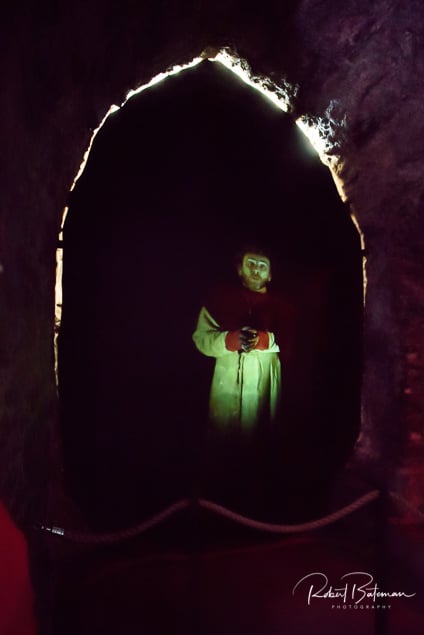 Hook Head characters of the past come to life through the use of holograms and video
Hook Head characters of the past come to life through the use of holograms and video
From the first beacon of light lit by monks to guide the Mariners safely on their journey, the lighthouse has had many changes to its lighting system from the first Fire to Coal, Oil (whale oil), Gas light, Paraffin Oil, (1911) Electricity (1972). In March 1996 Hook Lighthouse was switched to operate automatically and the last of the lighthouse keepers manually turned on the light for the last time before automation took over. Today it is monitored remotely by the Commissioners of Irish Lights in Dun Laoghaire.
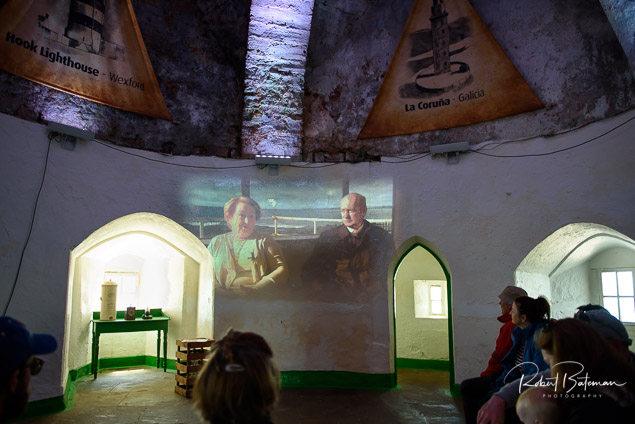
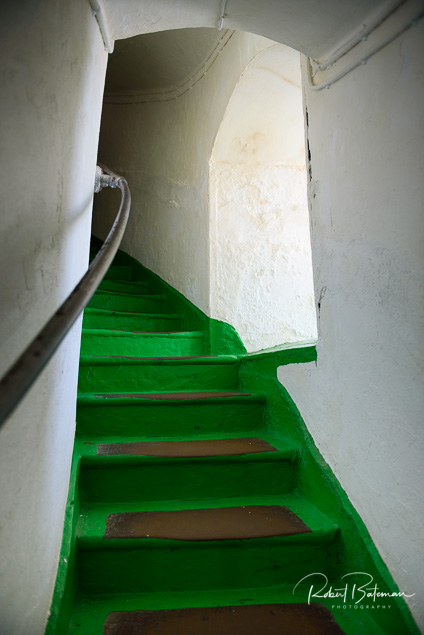

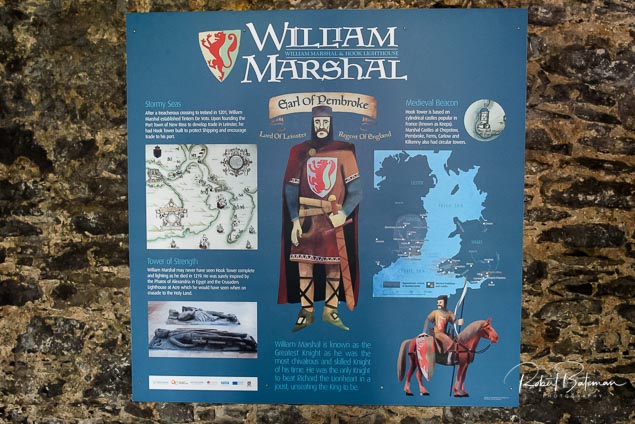


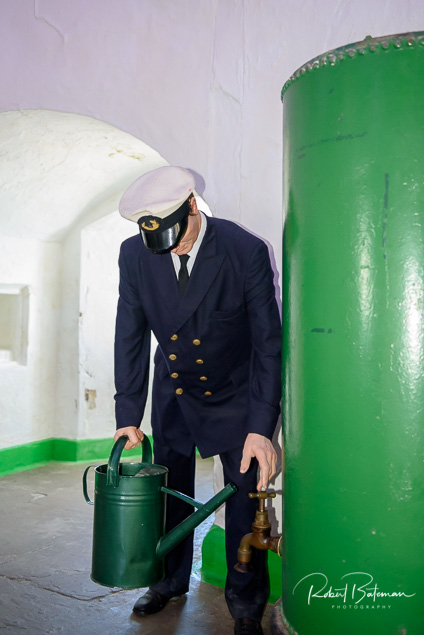
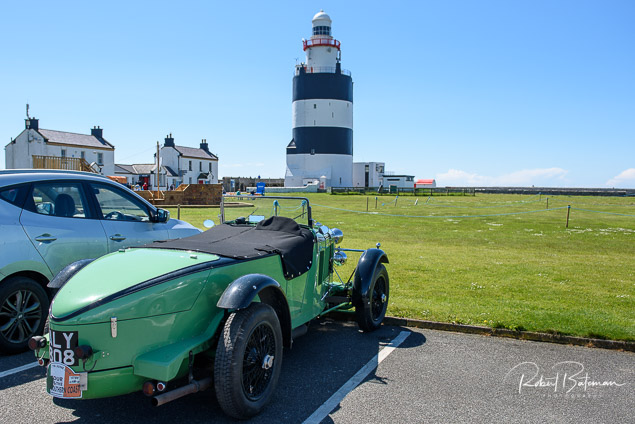

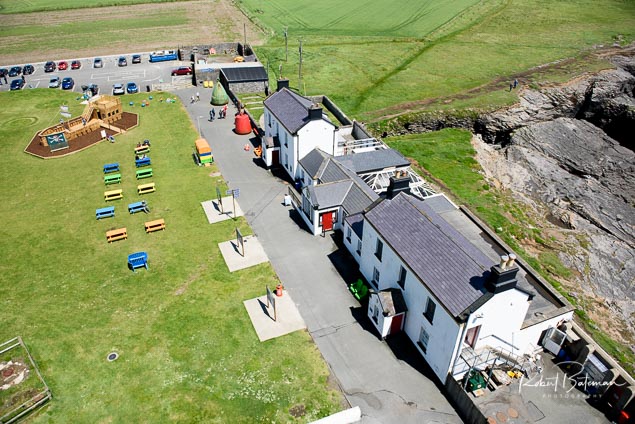
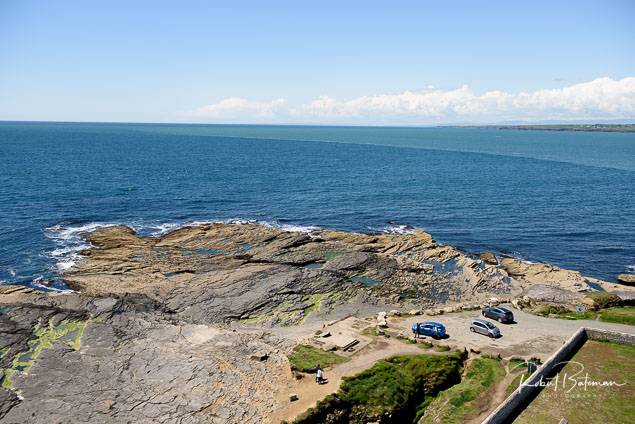

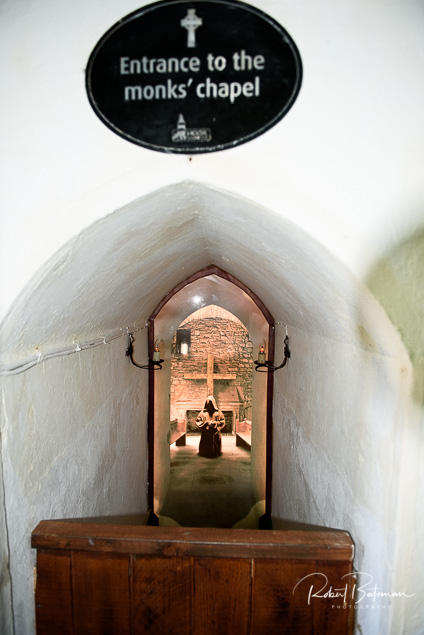


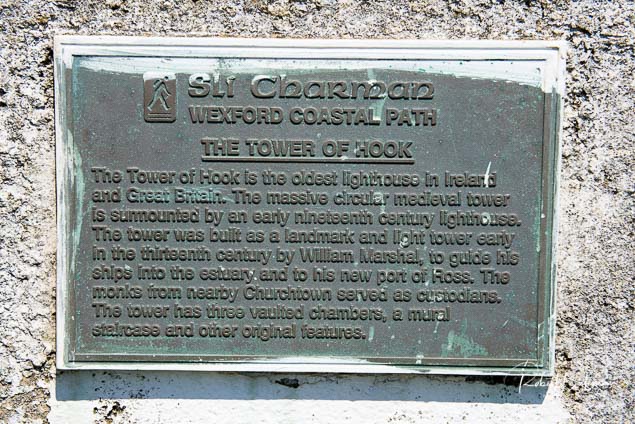
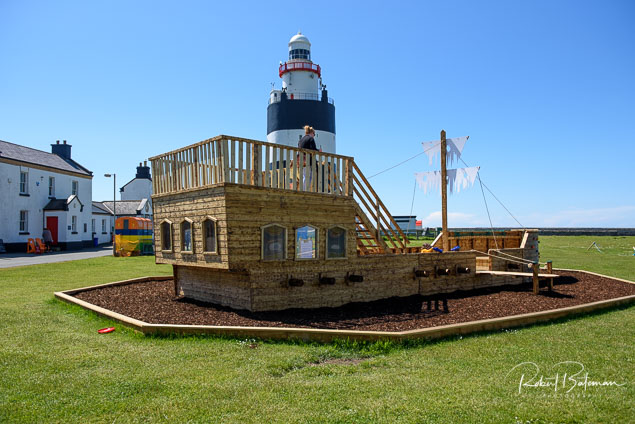

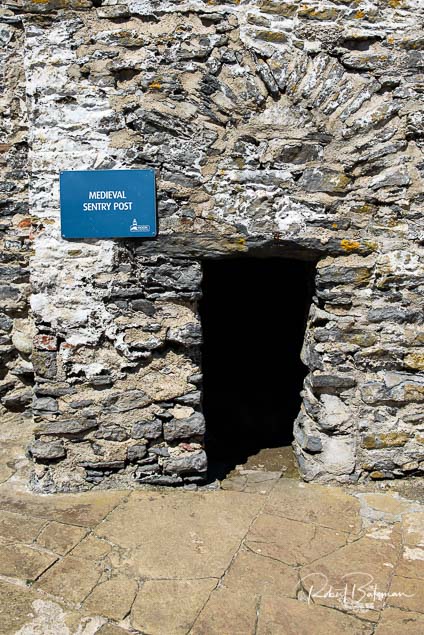

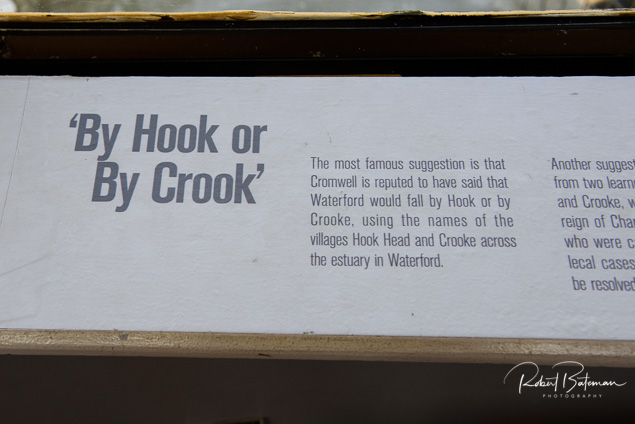
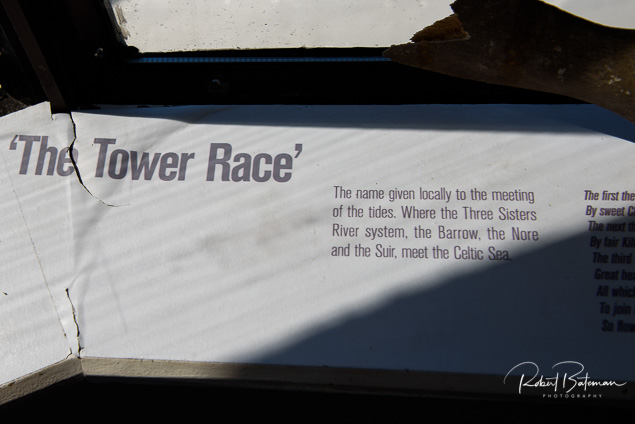
Hook Head Angler In Close Encounter With Shark
#Angling - Hours after a Belfast angler had a close call with a blue shark on an angling trip off Cork, a Wexford angler got more than he expected at the end of his line last weekend.
As Independent.ie reports, Cerjegs Zamahaev had been fishing for cod off Hook Head last Sunday 2 September, but instead hooked into a shark of his own.
Zamahaev released what’s since been identified as a tope shark or school shark — similar to the blue shark that left Robert Malcolmson with a serious wound on his arm as he and friends landed it on their deep sea angling charter.
Hook Head on Good Friday – Another Lighthouse Experience
The world’s oldest original operational lighthouse at Hook Head has been developing a series of unusual events. To mark the “beginning of Spring” it celebrates Ireland’s ‘Fire Goddess', by staging the first Imbolc Festival to be celebrated at the 800-year-old lighthouse.
Now it has announced that it will host another unusual event this Good Friday - a Sunset Tour Experience.
Jutting out to sea at the tip of the Hook Peninsula on the corner of Ireland’s Ancient East, there is, the Hook Head Lighthouse people say “no better place to take in the vast seascapes and glorious colours of Ireland’s Celtic Sea.”
They are not short of words or ideas at Hook!
The Sunset Tour Experience will offer visitors the opportunity to take a guided tour up the 115 well-worn steps of the medieval tower and see its heritage come to life as they meet life-sized figures of the Monk who first kept a beacon alight at the site in the 5th century followed by the Knight who built the tower, William Marshal and hear of life as a light-keeper before stepping on to the top floor outdoor balcony to take in the 360degree sweeping views of the Southeast of Ireland as the sun goes down.
“Tours culminate with the spectacular panoramic views of the rolling seas stretching out while visitors savour Irish mead, prosecco, fresh tea and coffee along with Ballyhack smokehouse smoked salmon on homemade brown bread, a selection of homemade canapés and homemade mini desserts in the private lighthouse watch-room and balcony,” according to the announcement.
The Sunset Tours Experience is available by advance booking only. Tickets are €45.00 per person and the organisers say this is an “adult only experience.” Tickets can be booked online at www.hookheritage.ie or by calling 051 397055.
Free facilities at Hook Lighthouse in County Wexford include parking, toilets, garden picnic areas and Wifi.
Hook Head Celebrates the Celtic Fire Goddess
Hook Head Lighthouse is to celebrate Ireland’s ‘Fire Goddess,’ reports Tom MacSweeney, by staging the first Imbolc Festival to be celebrated at the 800-year-old lighthouse.
Imbolc is a Gaelic traditional festival marking the beginning of spring, it is also the feast of St. Bridget, in ancient Irish mythology, Bridget was a fire goddess. She is also the patron saint of boatmen, sailors, and mariners. Imbolc is one of the lesser-known festivals of the ancient Celts, but it was one of the four most important festivals in the Celtic calendar and it is set to be revived and celebrated at the 800-year-old lighthouse on February 2, 3 and 4.
The event will include ‘A Fire in the Head' spoken word evening, celebrating the turning of the Celtic year; poetry, stories, and song will be shared by candlelight, all under the theme of fire and water. The story of St. Bridget of Kildare will also be shared. A spoken word event will take place with an open invitation to storytellers, poets, rappers and all wordsmiths to join the occasion the ‘word’ competition around the theme of Imbolc, this spoken word event will be judged by none other than best-selling author Cat Hogan and the winner will be awarded tickets to the Kieran Goss concert which is due to take place at the lighthouse in the summer.
There will also be a ‘Celtic Goddess Ceremony’ on the theme of ‘quickening' is set to take place. The word Imbolc means literally "in the belly" in the old Irish Neolithic language, and is symbolic of the beginning of the season and signals the 'quickening of the year'. At 12 noon on Sunday, Baya Salmon-Hawk will perform a Celtic Goddess Ceremony on the theme of ‘quickening within you' commencing the ceremony at St Dubhan's Well located at Dubhan's church ruins and walking to lighthouse into garden cobbled maze, in the centre of maze participants can tie Spring wishes on the Imbolc tree sculpture surrounded by the fire-baskets lighting in maze garden.
Marine Minister Introduces Conservation Measures Proposed By National Inshore Fisheries Forum
#Fishing - Marine Minister Michael Creed signed into law conservation measures concerning Irish velvet crab stocks as he hosted the 12th meeting of the National Inshore Fisheries Forum (NIFF) today, Wednesday 27 September.
The Inshore Fisheries Forum structures, which include the NIFF and six Regional Inshore Fisheries Forums (RIFFs), were established in 2014 to foster stakeholder-led development of proposals for the inshore fishing sector.
As well as moved to protect Irish velvet crab, the minister also introduced measures to regulate fishing activities affecting Natura 2000 sites at Hook Head and the Saltee Islands.
Regulations signed by Minister Creed today will introduce a Minimum Conservation Reference Size (MCRS) of 65mm for velvet crab that will apply to Irish sea fishing boats from 1 January 2018.
This measure was initially developed by the West Regional Inshore Fisheries Forum (RIFF) with advice from the Marine Institute. The proposal was brought to the minister last year by the NIFF, and a public consultation on the measure was held at the end of 2016.
Velvet crab are fished all year, but mainly in the March to October period, and they are predominantly a by-catch in the lobster fishery. Landings of velvet crab into Ireland were 406 tonnes in 2015, higher than any year since 2004, and were valued at just under €808,000. Over 80% of velvet crabs are landed by vessels less than 10 metres in length.
Additionally, a Fisheries Natura Declaration signed by Minister Creed today will restrict fishing using dredge and trawling gear for scallop fishing to protect certain sensitive habitats in Natura 2000 conservation sites off the southeast coast of Wexford from 30 November.
The Natura 2000 sites include the Hook Head and Saltee Islands SACs (Special Areas of Conservation). The declaration also sets down monitoring and notification requirements for boats fishing using dredge and trawling gear within these habitats.
These gear and monitoring measures were developed through industry members working with the Marine Institute and Bord Iascaigh Mhara (BIM) to address risks to sensitive habitats in the Hook Head and Saltee Islands SACs. The risks were identified by the Marine Institute in a 2014 risk assessment report of sea-fishing activities in Natura 2000 sites in the Irish Sea.
Industry members – including individual scallop fishermen, members of the Southeast RIFF and representatives of the Irish South and East Fish Producers Organisation (ISEFPO) – met with the Marine Institute and BIM through 2015 and 2016 to develop risk mitigation proposals for the fishery. A public consultation on the resulting Mitigation Response Plan was carried out in 2016.
These measures are being introduced following full consultation with the Inshore Fisheries Forum structures.
“Heading into their third year, the forums have taken a lead in tackling conservation issues and changing practices with a view to long-term sustainability,” said Minister Creed. “I welcome the support these measures have received from the Forums which reflects the mature approach this sector is taking in dealing with its own challenges.”
Minister Creed and the NIFF discussed the implementation of the new measures and the status of other measures under review for important stocks such as lobster, brown crab and razor clams.
The minister also discussed the impact of Brexit on the fishing sector and the UK’s intention to withdraw from the London Fisheries Convention, which governs access to waters inside the 12-mile limit.
Commenting on issues arising for the sector from Brexit, Minister Creed noted: “While the implications of Brexit are far from clear at this point in time, I will continue to highlight Irish fisheries concerns on the EU agenda and work with other impacted EU member states and the Barnier team to ensure that fisheries are not isolated in the overall negotiations on a new EU/UK relationship.”


























